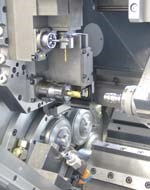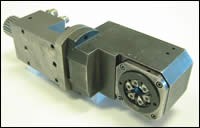Meet The Multi-Center
By: Chris Koepfer - Production Machining
How shops use the multi-spindle machine tool is changing. Complex workpieces, shorter production runs, rapid change-over and single part handling reflect the new reality of multi-spindle production. Builders are responding to these changing needs with new ways to make the multi-spindle machine more profitable, useful and efficient.
Thread Whirling On The Subspindle
By: Chris Koepfer - Production Machining
The screw machine industry, not surprisingly, started out making screws. Then, screw machines were used to make almost everything but screws—electrical components, aerospace fasteners, plumbing connections and thousands of other kinds of parts.
A Different Way To Turn
By: Chris Koepfer - Production Machining
The Esco concept turns turning 180 degrees. Unlike conventional lathes, the material, which is coil stock or bar from 0.02 mm to 12 mm, does not rotate. Stationary stock allows the use of round and profiled material.
Complex Angular Dental Implants...on Multi-Axis Automatic
Just like a car or a machine, the human body benefits from the technological progress of small parts turning equipment. Precision and stringent requirements for safety and stability are essential in the medical industry. In fact, the demands made on surgical screws (bone screws, maxillary-facial screws, implants and so on) and bio-implants can be much greater for the human body than for many industrial and commercial product applications.
Think You Can’t Afford New CNC Multi Technology?
At first glance, one might not think that spending hundreds of thousands of dollars on new CNC multi-spindle technology could actually improve a shop’s financial statement within several months, but it can and has at 64-year-old Kaddis Manufacturing in Rochester, New York.
Slashing Secondary Ops With New Swiss CNCs
This company employs 55 people. As labor costs have continued to grow, ownership has begun to realize that the only way to maintain profit margins is to become more efficient. Analyzing the operation, they've honed in on eliminating, or it least drastically reducing, secondary operations.
New Swiss Turning Technology Boosts Productivity For Contract Manufacturer
Technically, this control is not a CNC, but a PNC (parallel numerical control), and that is the difference. The PNC control was developed using a FANUC system that allows each machine axis to be governed by its own chip, which carries the part program.
Evolving From Conventional CNC To Advanced Swiss Technology
In 1999, this company and its management team started comparison shopping and decided to buy a this single spindle, Swiss-style CNC sliding headstock machine from their distributor. Now, the company says it can attract different types of work, especially high-precision jobs, because of the technology and versatility of this machine.
Evolving From Cam Multi-Spindles To CNC
There are thousands of cam-driven multi-spindles out in the field producing millions of parts 24 hours a day. And while there may always be a place for these machines when high volumes of relatively loose-tolerance parts are required, the tide is turning. CNC multi-spindles have emerged as a viable alternative now.






